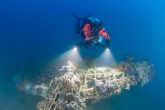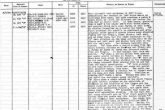German aircraft Arado Ar 196 (Crete)
-

Arado Ar 196. (Courtesy of Dimitris Galon) -

The dorsal part of the aircraft. (Photo by Kostas Milonakis) -

The tail section of the aircraft. The lining has melted and the frame can be seen. (Photo by Kostas Milonakis) -

AradoAr 196 in the Gulf of Souda during World War II. (Courtesy of Giannis Raptis) -

Remains of one of the floats next to the fuselage. (Photo by Kostas Milonakis) -

The aircraft is capsized at the bottom at a depth of 64 meters. (Photo by Kostas Milonakis) -

Loss entry of the pilot Karl-HeinzStienkemeier (registration number 73089/9) born on 27.11.1915. (Courtesy of Thanos Antonelos) -

Record entry of the attack by the four Allied Beaufighter 227th Long Range Fighter Squadron. (AIR 27/1409) -

In the area of the shipwreck there are fragments covered heavily by sediment. (Photo by Kostas Milonakis) -

Diver Giannis Liardakis investigates the aircraft engine. (Photo by Kostas Milonakis) -

Video from the Arado
German aircraft Arado Ar 196 (Crete)
In October 2020, Nikolas Giannoulakis, owner of the Chania Diving center, dived for the first time at the wreck of a German AradoAr 196 aircraft, which was shot down by Allied aircraft during World War II. The information was given to Nikos Giannoulakis by Giannis Georgitsakis, who located the aircraft in the bay of Kalathas, which is located 12 kilometers northeast of Chania. A few months later, in May 2021, Antonis Grafas and his team, consisting of Giannis Liardakis and Kostas Mylonakis, visited the area and with the support of Nikolas Giannoulakis dived the wreck for further research and documentation.
Technical Characteristics:
The Arado Ar 196 aircraft was a single-engine German multi-purpose seaplane, which was widely used on all fronts of World War II. It joined the Luftwaffe in October 1938 and served until the end of the war. After the war, it was used by the air forces of various countries, such as Romania and the USSR, until the mid-1950s. In Greece it was used during the war by the Luftwaffe mainly as a reconnaissance and escort escort. The general indicative technical characteristics of the aircraft were:
Type: General purpose aircraft
Manufacturer: Arado Flugzeugwerke GmbH
Length: 11 meters
Extension (length from the left end to the edge of the right wing): 12.47 meters
Height: 4.42 meters
Wing area: 28.40 square meters
Weight (empty): 2,090 kg
Maximum take-off weight: 3,720 kg
Engine: A 132 K Sternmotor
Power: 960 PS (716 kW)
Maximum speed: 309 kilometers per hour
Autonomy: 1,072 kilometers
Maximum height: 7,010 meters
Crew: 2 people
Indicative armament: Two 20 mm guns, two 7.9 mm machine guns and two 50 kg bombs.
Historical research:
The historical archival research which was carried out by Dimitris Galon with the assistance of aviation history researcher Thanos Antonelos, showed that it is obviously the German aircraft Arado Ar 196 with the side badges 7R + AK and the construction number (Werknummer) 0240, belonging to the 2nd Squadron of the 125th Reconnaissance Wing (2./Aufklärungsgruppe 125) based at Souda in Crete. According to Quartiermeister VI loss records, the aircraft, piloted by Ofw. Karl Stienkemeier and Bordoffizier Ltn. Wolf Zacharias, was shot down after a skirmish with four Allied Beaufighters on August 3, 1943. General German archival sources state the site of the incident was “7 kilometers northeast of Chania”. The archives also report the crew of the aircraft were lost during the crash. However, according to the loss record of the pilot Karl-Heinz Stienkemeier (registration number 73089/9), born on 27.11.1915, it is stated the pilot “was lost during a dog fight on the 03.08.1943, 15 kilometers northeast of Chania”, which completely eliminates the bay of Kalathas as the area of loss of the aircraft. According to British archival sources responsible for the downing of this particular Arado Ar 196 were four allied Beaufighter aircraft of the 227th Long Range Fighter Squadron of RAF, with the insignia BL 239 “N” (F / O Moor, F / O Turner), JL 730 “P” (F / SGT Thomas, F / SGT Thowes), BL 475 “R” (F / SGT Budd, F / SGT Jobling) and JL 541 “Q” (F / O Fright, F / SGT Brown) . According to the Business Calendar of the 227th Long Range Fighter Squadron of August 3, 1943: “At 12.30, at position 3541 North / 2407 East, two Arados were seen, with brown floats and painted black, flying in a formation heading south. The “N” aircraft first attacked the Arado, which was on the right side of the formation, managing to hit it on the floats, tail and wing, but the Arado was still flying. The “Q” aircraft then attacked, hitting the fuselage, the floats and the tail. Debris from the tail became visible in the air. Two guns blocked during the attack. The “N” aircraft then carried out a second attack, from the rear of the Arado, managing to hit the fuselage and the floats. Smoke or spray was observed coming out of the floats. It was thought to be fuel. The “Q” aircraft carried out a second attack from the rear, hitting the floats again. The Arado came very close to the surface of the water and then the “N” aircraft attacked from the left side hitting it on the fuselage. The enemy aircraft touched the surface of the water but immediately managed to rise again. The “R” aircraft then carried out an attack from the left side, managing to hit it on the floats from which smoke and fuel were coming out. Arado was then spotted trying to land, but crashed into the sea, capsized and sank immediately. The point of the crash was one mile in the direction of 90 degrees from Chania. No evacuation of the crew from the damaged enemy aircraft was witnessed. “
The shipwreck:
The wreck of the German aircraft Arado Ar 196 is capsized at a depth of 64 meters with its muzzle facing west. It is heavily covered by benthos and the lining of the fuselage, wings and tail has melted to a great extent over time and electrolysis, leaving a large part of the metal frame visible. Parts of the aircraft, such as the floats, have been detached from the fuselage and are lying on the seabed next to the aircraft. It should be noted that no penetrations were made into Arado Ar 196 and that the wreck was approached with respect as a sea grave.
DG
Sources
AIR 27/1409, Operations Record Book No. 227 Long Range Fighter Squadron, The National Archives, Kew Kriegstagebuch des Quartiermeisters VI (Verluste), Bundesarchiv (Abteilung Militärarchiv), Freiburg Dabrowski, Hans-Peter / Koos, Volker: See-Mehrzweckflugzeug Arado Ar 196. In: Waffen-Arsenal. Band 126. Podzun-Pallas-Verlag, Dorheim 1990 König, Christian: Adler über See. Bordflugzeug und Küstenaufklärer Arado Ar 196. Helios, Aachen 2016

